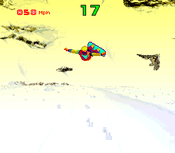Tommy Moe's Winter Extreme: Skiing & Snowboarding
| Tommy Moe's Winter Extreme Skiing & Snowboarding | |
|---|---|
 North American cover art | |
| Developer(s) | Loriciels |
| Publisher(s) | |
| Composer(s) | Michel Winogradoff[1] |
| Platform(s) | Super NES |
| Release date(s) | |
| Genre(s) | Snowboarding/skiing |
| Mode(s) | Single-player |
Tommy Moe's Winter Extreme: Skiing & Snowboarding is a winter sports video game for the Super Nintendo Entertainment System that uses skiing and snowboarding as extreme sports in either freestyle, training mode, or competition mode.[3] The game is known as Ski Paradise with Snowboard (スキーパラダイス WITH スノーボード)[4] in Japan and Val d'Isere Championship in Europe.
Gameplay

Competition mode allows the player to have three chances to successfully complete the challenges. Otherwise, he or she gets the "game over" screen advising the player to start over again. The freestyle mode plays like a video arcade racing game, the training mode allows the player to use any course, and the competition mode is like the Winter Olympic Games. Controls can be modified and the player can either use skis or snowboards. The game is named after US alpine skier Tommy Moe and is co-endorsed with Val-d'Isère; which hosted the men's downhill skiing event during the 1992 Winter Olympics in Albertville, France.[3] The Japanese version of the game also features as endorsement from Italian ski equipment company Nordica, evident on the game's box.
Conditions can change on the course, which can range from dawn, dusk, darkness, afternoon conditions, even forcing players to navigate through a winter storm. Once the player reaches the bottom of the hill in freestyle mode, either he or she must use the ski lift in order to climb to the top of the next mountain. There are less than 70 seconds to get to the next checkpoint. The fastest speed that snowboards can go is 66 miles per hour (106.2 kilometres per hour) on hilly terrain and 88 miles per hour (141.6 kilometres per hour) on flat terrain.
A password allows players to continue their saved progress as they explore new regions of the mountain and refine their skiing or snowboarding skills.
Reception
GamePro assigned the game a rating of 4 out of 5 in their February 1994 issue. Game Players gave it a score of 77%. This game was voted the "best simulation game of 1994" in GameFan magazine's annual Megawards.
References
- ↑ "Composer information". SNES Music. Retrieved 2013-01-13.
- ↑ "Release information". GameFAQs. Retrieved 2008-05-22.
- 1 2 "Release information". MobyGames. Retrieved 2011-12-28.
- ↑ "Japanese title". superfamicom.org. Retrieved 2008-05-22.